The Current View
A lengthy downtrend in sector prices had given way to a relatively stable trajectory after mid 2013 similar to that experienced in the latter part of the 1990s and first few years of the 2000s.
The late 1990s and early 2000s was a period of macroeconomic upheaval during which time sector pricing nonetheless proved relatively stable.
Relative stability suggests a chance for companies genuinely adding value through development success to see their share prices move higher. This was the experience in the late 1990s and early 2000s.
Still vulnerable cyclical conditions were aggravated in the second half of 2015 by a push from investors worldwide to reduce risk. Sector prices were pushed to a new cyclical low. These conditions were reversed through 2016 and 2017 although sector prices have done little more than revert to the 2013 levels which had once been regarded as cyclically weak.
With a median decline in prices of ASX-listed resources companies through the cycle of 89%(and 30% of companies suffering a decline of more then 95%), the majority of stocks remain prone to strong 'bottom of the cycle' leverage in response to even slight improvements in conditions.
Has Anything Changed?
The strength of the US dollar exchange rate since mid 2014 had added an unusual weight to US dollar prices. Reversal of some of the currency gains has been adding to commodity price strength through 2017.
Signs of cyclical stabilisation in sector equity prices has meant some very strong ‘bottom of the cycle’ gains.
Funding for project development has passed its most difficult phase with the appearance of a stronger risk appetite.

Resource Sector Weekly Returns

Market Breadth Statistics
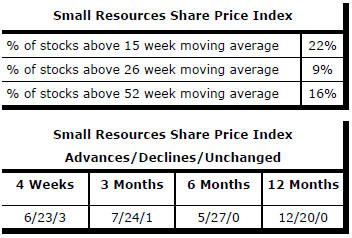
52 Week Price Ranges

Equity Markets
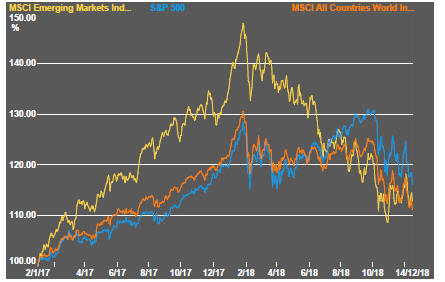

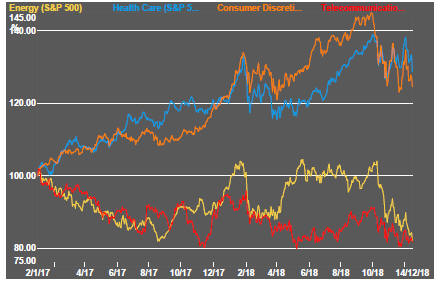
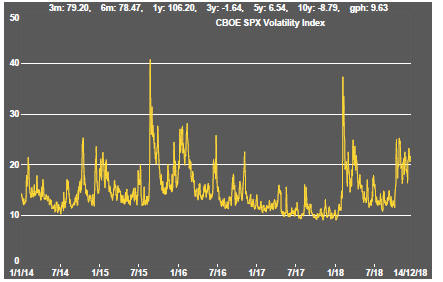
Large day-to-day and intraday swings have continued to typify movements in US equity prices as the downward drift gained momentum, positioning US indices for some of the largest monthly falls in decades.
The combination of influential factors remains a familiar list comprising worries about Federal Reserve intentions, Sino-US trade policy tensions and, increasingly, nervousness about a slowdown in global economic growth.
Many investors have been waiting to hear what US Federal Reserve chairman Jerome Powell will say after an upcoming December meeting of the policy making arm of the central bank. A rate rise has been a foregone conclusion for many weeks but investors would like to know whether the Fed will then put further rises on hold subject to the flow of data rather than pursue a predetermined course and rises and securities sales.
The Federal Reserve, whatever it chooses to do this month, is set to offer progressively less support for markets. Until the end point of its policies is more clearly defined, and in the absence of more robust earnings growth expectations, the downward pressures on markets are likely to persist.
A global shift in policy toward tighter monetary conditions with adverse consequences for equity prices was also evident in Europe where the European Central Bank confirmed that it would stop buying securities. Chinese activity data was also suggestive of a slowdown, confirming the mounting sense of downside risk from that source.
While market falls have mounted, daily movements have been largely orderly. Sectors which have been losing momentum, such as housing, are showing weakness and warrant some reappraisal of company valuations.
As sector growth prospects change and global growth slackens, some re-pricing of equities is inevitable. The transition to a new equilibrium has been destabilised by the increasing impact of autonomous trading machines reacting to technical benchmarks and leading to highly unusual daily volatility, at least by historical standards.
Resource Sector Equities
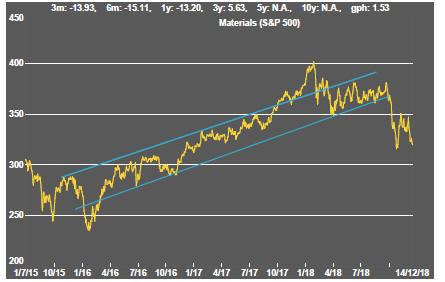


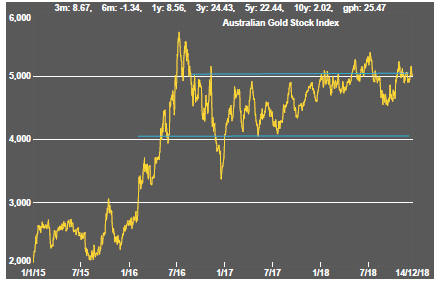
Somewhat incongruously in a market in which risks to growth are supposedly on the rise, mining sector stock prices proved relatively resilient. Prices of the market leaders rose over the week after having weakened over the past three months. Even the growth sensitive exploration stocks made a small positive contribution.
The disparate performance between the prices of global miners and US companies suggests that market declines in the past week may be a more US-specific issue dressed up as a response to worries about global growth by people looking for easy reasons. Relatively large falls in the Russell 2000 share price index are also suggestive of domestic influences, rather than international growth duress, dominating outcomes.
Interest Rates


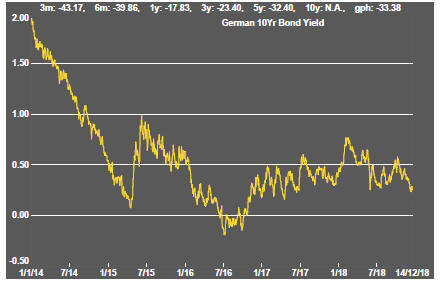


Government long dated bond yields have eased, consistent with the narrative about slower global growth. A reallocation of funds flowing away from equities will have also been a factor. Yield movements seem to be signalling to policymakers that the market has a different view of the direction in which policy should trend than those with their hands on the official levers.
The difference in view between markets and policymakers has led to a stepped up concern about a shrinking yield spread. Although there is conjecture about the effect on macroeconomic activity of a yield curve inversion, narrowing official interest rate spreads have added to equity market anxieties.
Judgements about the impact of contracting yield spreads are complicated by the unpredictable duration of the lagged effect on activity as well as, presently, by the large Federal Reserve holdings of longer dated securities which have tended to depress yields relative to historical experience at the equivalent time in earlier cycles.
Corporate bond yields continue to display a rising bias in a sign for the mining industry that access to funding is getting harder.
Exchange Rates





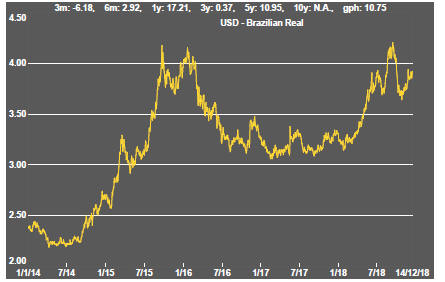
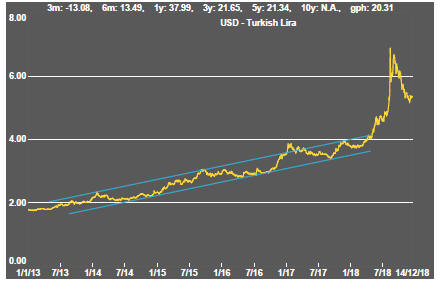

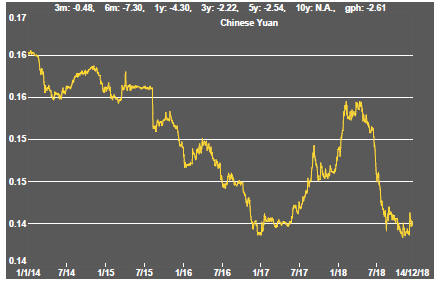

The upward bias in the US dollar remained evident. Weakness in sterling has been aggravated by the shemozzle in the UK House of Commons where there is no majority for any single option for how to implement the country’s referendum on European Union membership. Weak European growth outcomes, whatever happens on the Brexit front, are having a negative impact on the euro.
A weaker Australian dollar helped sustain gold equity prices despite stock market conditions and a drop in the gold bullion price.
Commodity Prices

The general upswing in commodity prices since mid 2017 had been given added impetus by stronger crude oil prices which have, more recently, underpinned a reversal in the trend.
The cost pressures which had been reported by many companies as a result of higher commodity prices should be easing and removing a source of upward pressure on selling prices which would, in turn, reduce the potential impact on inflation and on interest rates. One of the causes of disquiet about the intentions of the Federal Reserve arises from its pursuit of higher interest rates even as inflation continues to undershoot official targets.
Gold & Precious Metals



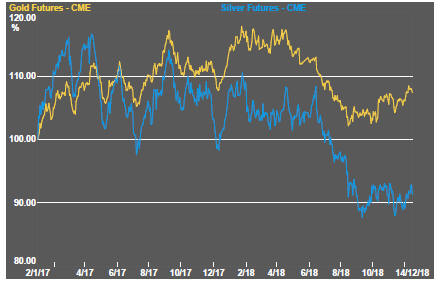
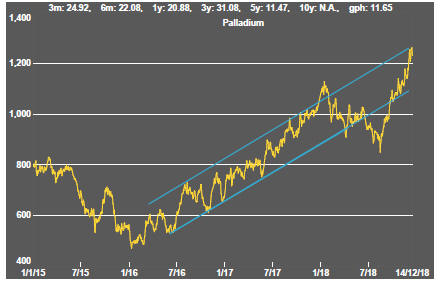
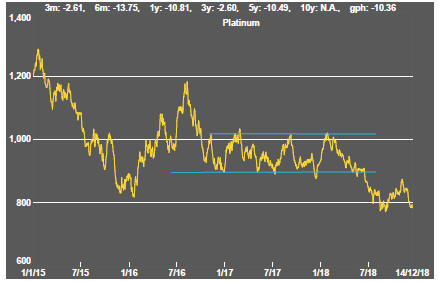

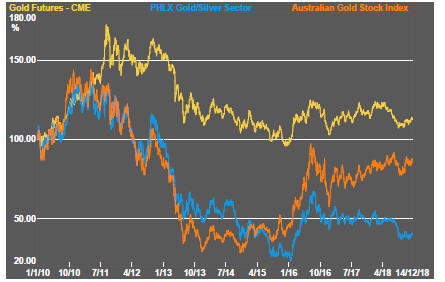
Gold, silver & platinum prices declined although higher bond prices would have supported bullion prices. This technical connection should persist but the likelihood of a large upward movement in bond prices appears low presently. Gold had also been overpriced relative to bond prices, limiting the leverage of the precious metal price to a change in financial market conditions.
Palladium prices moved higher once again and are now at the upper end of the trading channel dating from the beginning of 2016.
Nonferrous Metals



Daily traded nonferrous metal prices, with the exception of tin, were lower. Tin has shown the strongest price performance of the six main traded metals (and the only metal with a positive return) over the past 12 months.
Copper price movements had been at odds with higher bond yields which would normally signal strengthening inflation and growth, both good signs for the metal markets. The divergence had intimated the possibility of a future resolution of the implied difference in opinion as the global growth trajectory became clearer. In the past week, the verdict appears to have favoured weaker growth and lower bond yields with, at best, stable copper prices.
Bulk Commodities

The iron ore price posted a small rise in the past week after a multi-week decline prompted by falling Chinese steel prices.
Chinese economic growth reports show the national economy meeting its targets, as one would expect for a centrally planned economy, but without any overt signs of upside risk. The tariff fight with the USA is beginning to take a toll on activity rates in an economy with a bias toward less strong growth in the years ahead.
Reported GDP growth in the September quarter was consistent with official forecasts although hitting the targets is becoming more challenging by the year.
The latest manufacturers purchasing managers index for China, measuring conditions in October, implied continuing slowing in momentum.
Coal prices slipped further during the week, albeit after some strong gains through the middle months of 2018. China reported growth in coal output between September and August and over the year to September with plans to open new capacity proceeding as the country switches to larger more efficient sources of coal production.
Oil and Gas

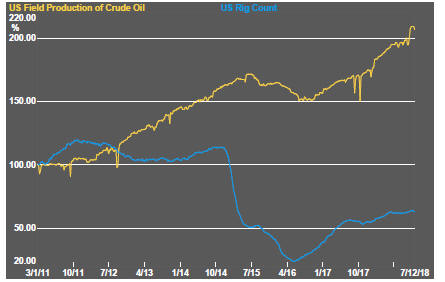

The US crude oil price dropped again although the rate of descent eased somewhere. At the same time, the collapse in equity prices for oil and gas exploration and production companies gained force. Moderation in the rate of oil price decline had little impact amid weakening equity prices. Important, too, would have been deteriorating corporate bond markets which are a significant influence on the capacity of the oil and gas sector to maintain their development momentum.
OPEC has had to enlist the help of Russia to put a break on recent price weakness but higher prices will underpin continued production growth in the USA, now one of the three major global producers along with Saudi Arabia and Russia. Texas alone is positioned to be the third largest producer after Russia and Saudi Arabia. Export infrastructure limitations may be the greatest impediment to US production having a greater effect on international energy prices.
OPEC has been losing its market impact and, in battling to manage price outcomes, may be adding to volatility by encouraging traders to anticipate its next move and react to news which might affect future decisions by the cartel.
Battery Metals


Eighteen months of rising lithium-related stock prices have given way to a prolonged period of market reassessment as a lengthy pipeline of potential new projects has raised the prospect of ongoing supplies better matching expected needs.
Potential lithium producers have been able to respond far more quickly to market signals than has been the case in other segments of the mining industry where development prospects have been slowed by reticence among financiers to back development.
Movements in lithium related equity prices had been aligned more closely with overall sector equity prices through most of 2018.

Battery metals remain a focal point for investors with recent attention moving to cobalt and vanadium.
Doubts about political conditions in the Democratic Republic of the Congo (and instances of Ebola) have added a dimension to cobalt prices lacking in other metals caught up in the excitement over the longer term impact of transport electrification. Short term market tightness relating to non-battery demand is easing.
In the longer term, cobalt is the most vulnerable of the battery related metals to substitution with high prices likely to stimulate research in that direction.
A spokesperson for Panasonic, manufacturer of batteries for Tesla motor vehicles, has been quoted as saying that the company intends to halve the cobalt content of its batteries because of uncertainties over supply although, offsetting such a move, will be the rapid increase in the number of units produced.
Uranium
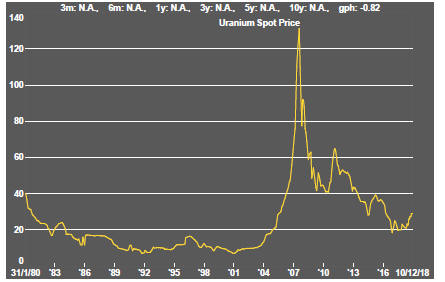

The uranium sector is in the midst of forming a prolonged cyclical trough as market balances slowly improve. Power utilities have been reluctant to re-enter the market for contracted amounts of metal to meet longer term needs although an upward bias in prices is now evident.
The effect of an announcement by Canadian producer Cameco to extend the duration of its previously implemented production cut gave the market a very slight but quickly lost lift.
Slightly higher equity prices from time to time, in the hope of improved conditions, have not been sustained but could be repeated as speculation about improved future demand ebbs and flows.
News that the Kazakhstan government intends to list its state owned uranium producer, also the world's largest producer, may suggest greater responsiveness to market conditions and less emphasis on production to maximise government revenue.

The Steak or Sizzle? blog LINK contains additional commentary on the best performed stocks in the sector and the extent to which their investment outcomes are underpinned by a strong enough value proposition to sustain the gains.


